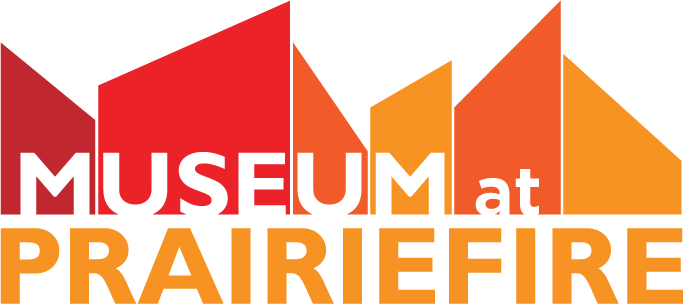Featured Events
Paws for Progress
Join KC Urban Advantage and Great Plains SPCA as we partner to help spread awareness in the communities we serve! Enjoy an evening of craft cocktails and scrumptious small bites, a silent auction with a raffle featuring some great prizes and more! Together, we can make a difference!
Use code EarlybirdMAP for $5 off the event, valid through 3/4, for the first 25 tickets!
Join us for Science Happy Hour with a TWIST as we watch the breathtaking documentary premiere of Crest Alta! A journey to Alaska, Iceland, Chile and Peru to document glaciological research expeditions and sustainability. The Cresta Alta Film Tour is engaging audiences throughout the US with arts councils, colleges, high schools and museums at events produced by The Risan Project. The 2025 tour features Risan Media's expedition-based climate change documentary film titled, Cresta Alta, that chronicles a journey to Alaska, Iceland, Chile and Peru to document glaciological research expeditions and sustainability. The screenings are followed by a discussion/Q&A with producer and director, Todd Anders Johnson.
Wednesday, April 16th
Doors open at 5:30 PM for Happy Hour drinks
Talk begins at 6PM
Tickets are FREE for membership and $10 for non-members
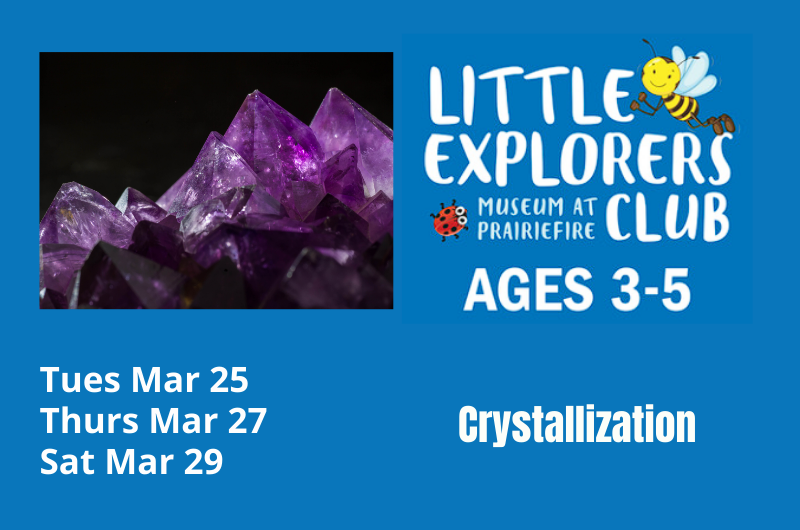
Little Explorer’s Club: Crystallization
Join us as we dive into the fascinating world of crystals! In this fun, hands-on class, little explorers will discover how crystals form and grow through exciting experiments and playful activities. We'll explore the process of crystallization and watch as sparkling shapes come to life.

JAM Sessions: Sprouting Seeds
What soil nutrients do plants need to grow their best? If you are a gardener, sometimes you have to wait what seems like a long time before plants begin to poke their leaves and stems through the soil and into daylight to find out. If you do this enough and you do some research, though, you can figure out 1) what nutrients certain plants need, and 2) what supplements may help them grow healthier before you ever put seeds in the ground! In this life-science activity, you will set up and conduct an experiment to determine whether seeds will sprout faster in soil mixed with coffee grounds or just “regular” soil and learn a little about how seeds turn into plants.

Little Explorer’s Club: Magnets
Join us for a fun and interactive adventure as we explore the magic of magnets! Little scientists will discover how magnets work, experiment with attraction and repulsion, and engage in hands-on activities that make learning science exciting.

Little Explorer’s Club: Magnets
Join us for a fun and interactive adventure as we explore the magic of magnets! Little scientists will discover how magnets work, experiment with attraction and repulsion, and engage in hands-on activities that make learning science exciting.

JAM Sessions: Sprouting Seeds
What soil nutrients do plants need to grow their best? If you are a gardener, sometimes you have to wait what seems like a long time before plants begin to poke their leaves and stems through the soil and into daylight to find out. If you do this enough and you do some research, though, you can figure out 1) what nutrients certain plants need, and 2) what supplements may help them grow healthier before you ever put seeds in the ground! In this life-science activity, you will set up and conduct an experiment to determine whether seeds will sprout faster in soil mixed with coffee grounds or just “regular” soil and learn a little about how seeds turn into plants.

Little Explorer’s Club: Magnets
Join us for a fun and interactive adventure as we explore the magic of magnets! Little scientists will discover how magnets work, experiment with attraction and repulsion, and engage in hands-on activities that make learning science exciting.

JAM Sessions: Symbiotic Relationships in Nature
Spring has begun, and you may have noticed that birds are singing their songs again. You may have noticed the first flower blooms of the season. Take a close look inside the flowers, and you will likely see an insect visiting that flower. Flowers and insects have had a very close relationship with each other for a very long time…dating back to when dinosaurs were alive! We call this type of relationship a symbiotic relationship, and the relationship between insects and flowers is just one of many examples in nature. In this JAM, you will learn how the organisms in these interesting associations help one another.

Little Explorer’s Club: Masks Around the World
Travel the globe through the art of masks! Little explorers will discover the history and cultural significance of masks from different regions, then create their own unique mask to take home.

JAM Sessions: Symbiotic Relationships in Nature
Spring has begun, and you may have noticed that birds are singing their songs again. You may have noticed the first flower blooms of the season. Take a close look inside the flowers, and you will likely see an insect visiting that flower. Flowers and insects have had a very close relationship with each other for a very long time…dating back to when dinosaurs were alive! We call this type of relationship a symbiotic relationship, and the relationship between insects and flowers is just one of many examples in nature. In this JAM, you will learn how the organisms in these interesting associations help one another.

Little Explorer’s Club: Masks Around the World
Travel the globe through the art of masks! Little explorers will discover the history and cultural significance of masks from different regions, then create their own unique mask to take home.

Little Explorer’s Club: Masks Around the World
Travel the globe through the art of masks! Little explorers will discover the history and cultural significance of masks from different regions, then create their own unique mask to take home.

JAM Sessions: Build Your Own Water Filter
We all rely on clean, drinkable water to survive. (Remember that most of our body is water.) The water in our bodies must be replenished by drinking plenty of it during the day. How do we get water that we can drink? The water that comes to us from our environment is not usually drinkable—it must be treated to remove harmful substances in it. One type of treatment involves filtration. Filtration removes substances and microscopic organisms that float in the water, as well as some substances that are dissolved in it. Using materials from the pet and hardware stores, you can construct your own water filtration device to see how this treatment process works.

Little Explorer’s Club: Stories Through the Ages
Travel through time with us as we explore storytelling from ancient myths to modern tales! Little explorers will discover how stories have been shared across generations through art, symbols, and spoken word, with fun, hands-on activities to bring history to life.

Little Explorer’s Club: Stories Through the Ages
Travel through time with us as we explore storytelling from ancient myths to modern tales! Little explorers will discover how stories have been shared across generations through art, symbols, and spoken word, with fun, hands-on activities to bring history to life.

JAM Sessions: Build Your Own Water Filter
We all rely on clean, drinkable water to survive. (Remember that most of our body is water.) The water in our bodies must be replenished by drinking plenty of it during the day. How do we get water that we can drink? The water that comes to us from our environment is not usually drinkable—it must be treated to remove harmful substances in it. One type of treatment involves filtration. Filtration removes substances and microscopic organisms that float in the water, as well as some substances that are dissolved in it. Using materials from the pet and hardware stores, you can construct your own water filtration device to see how this treatment process works.

Little Explorer’s Club: Stories Through the Ages
Travel through time with us as we explore storytelling from ancient myths to modern tales! Little explorers will discover how stories have been shared across generations through art, symbols, and spoken word, with fun, hands-on activities to bring history to life.

JAM Sessions: Film Canister Rockets
How do rockets travel into space? You may know that it takes fuel to simply get a rocket off the ground and that the rocket also needs to escape the Earth’s gravity to actually get out of our orbit…which requires a lot of fuel! Fuel can, and has been, made in different ways to generate the forces required to lift rockets. In this aero engineering-themed JAM, you will learn how fuel helps generate these forces—by launching a film canister. You will use two simple ingredients to make your fuel, change the ratios after each launch, and make observations about how the changes in fuel ingredients affects their distance traveled.

Little Explorer’s Club: Stars
Blast off into the wonders of the night sky! Little astronomers will explore what stars are, how they shine, and create their own starry masterpiece in this fun, hands-on adventure.

Little Explorer’s Club: Stars
Blast off into the wonders of the night sky! Little astronomers will explore what stars are, how they shine, and create their own starry masterpiece in this fun, hands-on adventure.

JAM Sessions: Film Canister Rockets
How do rockets travel into space? You may know that it takes fuel to simply get a rocket off the ground and that the rocket also needs to escape the Earth’s gravity to actually get out of our orbit…which requires a lot of fuel! Fuel can, and has been, made in different ways to generate the forces required to lift rockets. In this aero engineering-themed JAM, you will learn how fuel helps generate these forces—by launching a film canister. You will use two simple ingredients to make your fuel, change the ratios after each launch, and make observations about how the changes in fuel ingredients affects their distance traveled.

Little Explorer’s Club: Stars
Blast off into the wonders of the night sky! Little astronomers will explore what stars are, how they shine, and create their own starry masterpiece in this fun, hands-on adventure.

JAM Sessions: Misunderstood Animals - Snakes
What do snakes do for our native habitats here in northeast Kansas? Can you identify any local snakes and which ones are potentially dangerous? Snakes can be found in a variety of habitats - even in the KC metro, there are plenty of parks and natural areas where they can be found. And more often than not, they will see you before you see them!
Sadly, snakes are often misunderstood animals. While there certainly are dangerous snakes to watch out for, snakes play a vital role in their habitats as both predator and prey. In this JAM, we will learn about these fascinating animals and maybe go on a walk in our wetlands to search for two common snakes we have in this area!

Little Explorer’s Club: Turtles & Tortoises
Shell-ebrate the amazing world of turtles and tortoises! Little explorers will learn the differences between these fascinating reptiles, discover their unique adaptations, and engage in hands-on activities to bring their learning to life.

Little Explorer’s Club: Turtles & Tortoises
Shell-ebrate the amazing world of turtles and tortoises! Little explorers will learn the differences between these fascinating reptiles, discover their unique adaptations, and engage in hands-on activities to bring their learning to life.

JAM Sessions: Misunderstood Animals - Snakes
What do snakes do for our native habitats here in northeast Kansas? Can you identify any local snakes and which ones are potentially dangerous? Snakes can be found in a variety of habitats - even in the KC metro, there are plenty of parks and natural areas where they can be found. And more often than not, they will see you before you see them!
Sadly, snakes are often misunderstood animals. While there certainly are dangerous snakes to watch out for, snakes play a vital role in their habitats as both predator and prey. In this JAM, we will learn about these fascinating animals and maybe go on a walk in our wetlands to search for two common snakes we have in this area!

Little Explorer’s Club: Turtles & Tortoises
Shell-ebrate the amazing world of turtles and tortoises! Little explorers will learn the differences between these fascinating reptiles, discover their unique adaptations, and engage in hands-on activities to bring their learning to life.

JAM Sessions: Misunderstood Animals - Bats
Did you know that bats live in Kansas? What do you think bats do in our native habitats, and where is the best place to find them? There are a few different species native to Kansas, and part of what makes these animals mysterious is the fact that they are nocturnal. Being nocturnal creatures, though, makes them a unique piece of the ecological puzzle.
There are also myths and misconceptions about bats - think vampire bats! - that leads to misunderstandings about these animals. In this JAM, we will learn what makes these animals unique and beneficial to their habitats and to humans.

Little Explorer’s Club: Outstanding Owls
Discover the wonders of owls! Little explorers will learn about these amazing nocturnal birds, their unique adaptations. Join us for a hoot of a time with fun, hands-on activities!

JAM Sessions: Misunderstood Animals - Bats
Did you know that bats live in Kansas? What do you think bats do in our native habitats, and where is the best place to find them? There are a few different species native to Kansas, and part of what makes these animals mysterious is the fact that they are nocturnal. Being nocturnal creatures, though, makes them a unique piece of the ecological puzzle.
There are also myths and misconceptions about bats - think vampire bats! - that leads to misunderstandings about these animals. In this JAM, we will learn what makes these animals unique and beneficial to their habitats and to humans.

Little Explorer’s Club: Outstanding Owls
Discover the wonders of owls! Little explorers will learn about these amazing nocturnal birds, their unique adaptations. Join us for a hoot of a time with fun, hands-on activities!

Little Explorer’s Club: Outstanding Owls
Discover the wonders of owls! Little explorers will learn about these amazing nocturnal birds, their unique adaptations. Join us for a hoot of a time with fun, hands-on activities!

JAM Sessions: Ice Cream in a Bag
Anybody up for some ice cream? Following the steps in this activity, you can make your own. July is a great time to enjoy some cold, refreshing ice cream. As with any kind of cooking and food making, there is science involved. There are chemical changes that happen when making ice cream, such as changes of state and the effect of adding substances that lower the freezing temperature of water. And in the end, you get to eat your science!

Little Explorer’s Club: Shooting Stars & Meteors
Blast off on a cosmic adventure as we explore shooting stars and meteors! Little scientists will learn what makes meteors streak across the sky, create their own meteor crafts, and discover the wonders of space through fun, hands-on activities.

JAM Sessions: Ice Cream in a Bag
Anybody up for some ice cream? Following the steps in this activity, you can make your own. July is a great time to enjoy some cold, refreshing ice cream. As with any kind of cooking and food making, there is science involved. There are chemical changes that happen when making ice cream, such as changes of state and the effect of adding substances that lower the freezing temperature of water. And in the end, you get to eat your science!

Little Explorer’s Club: Shooting Stars & Meteors
Blast off on a cosmic adventure as we explore shooting stars and meteors! Little scientists will learn what makes meteors streak across the sky, create their own meteor crafts, and discover the wonders of space through fun, hands-on activities.

Little Explorer’s Club: Shooting Stars & Meteors
Blast off on a cosmic adventure as we explore shooting stars and meteors! Little scientists will learn what makes meteors streak across the sky, create their own meteor crafts, and discover the wonders of space through fun, hands-on activities.

JAM Sessions: What’s Swimming in your Creek?
When you think of a wetland (maybe a marsh, swamp, or small creek flowing from a pond), what living things come to mind? Most of you can probably name a few large animals and at least one or two plants. Did you know, though, that these large living organisms actually depend on tiny, even microscopic, plants and animals to survive. Without them, a wetland would not function the way it does.
In this natural science JAM, you will each be given some sampling tools for collecting specimens in our creek water behind the museum. You’ll observe your “catch” through microscopes and learn about the amazing tiny things swimming in the creek!

Little Explorer’s Club: Human Body
Discover the amazing human body! Little scientists will explore how our bodies work, from our beating hearts to our busy brains, through fun hands-on activities and interactive learning.

JAM Sessions: What’s Swimming in your Creek?
When you think of a wetland (maybe a marsh, swamp, or small creek flowing from a pond), what living things come to mind? Most of you can probably name a few large animals and at least one or two plants. Did you know, though, that these large living organisms actually depend on tiny, even microscopic, plants and animals to survive. Without them, a wetland would not function the way it does.
In this natural science JAM, you will each be given some sampling tools for collecting specimens in our creek water behind the museum. You’ll observe your “catch” through microscopes and learn about the amazing tiny things swimming in the creek!

Little Explorer’s Club: Human Body
Discover the amazing human body! Little scientists will explore how our bodies work, from our beating hearts to our busy brains, through fun hands-on activities and interactive learning.

Little Explorer’s Club: Human Body
Discover the amazing human body! Little scientists will explore how our bodies work, from our beating hearts to our busy brains, through fun hands-on activities and interactive learning.

JAM Sessions: Sketching From Nature
Think of the last picture of a plant or an animal you saw in a book - was it a photograph or a drawing? We are all used to seeing images of nature through photographs in our books, magazines, and videos. Photography is a pretty young field, and early scientists couldn’t simply pull out a phone and snap a picture! So, how did they record the tiny details of natural objects? In this natural history JAM, we’ll take a look at some of the earliest drawings, even from ancient Roman and Greek times, of plants and animals these early scientists made. We will also go on our own exploration along the wetlands trail to find objects to sketch.

Little Explorer’s Club: Native Americans in Kansas
Journey through history as we learn about the Native American tribes of Kansas! Little explorers will discover their traditions, stories, and daily life through hands-on activities and engaging storytelling.

Little Explorer’s Club: Native Americans in Kansas
Journey through history as we learn about the Native American tribes of Kansas! Little explorers will discover their traditions, stories, and daily life through hands-on activities and engaging storytelling.

JAM Sessions: Sketching From Nature
Think of the last picture of a plant or an animal you saw in a book - was it a photograph or a drawing? We are all used to seeing images of nature through photographs in our books, magazines, and videos. Photography is a pretty young field, and early scientists couldn’t simply pull out a phone and snap a picture! So, how did they record the tiny details of natural objects? In this natural history JAM, we’ll take a look at some of the earliest drawings, even from ancient Roman and Greek times, of plants and animals these early scientists made. We will also go on our own exploration along the wetlands trail to find objects to sketch.

Little Explorer’s Club: Native Americans in Kansas
Journey through history as we learn about the Native American tribes of Kansas! Little explorers will discover their traditions, stories, and daily life through hands-on activities and engaging storytelling.

JAM Sessions: Science of the Cicada Symphony
We are now in the dog days of summer, the hottest part of the year. It is no surprise, then, that the noisy cicadas you’re hearing are called dog day cicadas! These are fascinating insects, and their calls seem to instantly bring warm summer evenings to mind. There are several species that fall into this group - and did you know that you and actually identify the different species by their song?
In this JAM, you will learn how and why cicadas make their calls and how they can be so loud! We’ll test our knowledge of cicada calls and walk along the wetlands trail for observation…possibly even handling. (They are harmless!)

JAM Sessions: Science of the Cicada Symphony
We are now in the dog days of summer, the hottest part of the year. It is no surprise, then, that the noisy cicadas you’re hearing are called dog day cicadas! These are fascinating insects, and their calls seem to instantly bring warm summer evenings to mind. There are several species that fall into this group - and did you know that you and actually identify the different species by their song?
In this JAM, you will learn how and why cicadas make their calls and how they can be so loud! We’ll test our knowledge of cicada calls and walk along the wetlands trail for observation…possibly even handling. (They are harmless!)
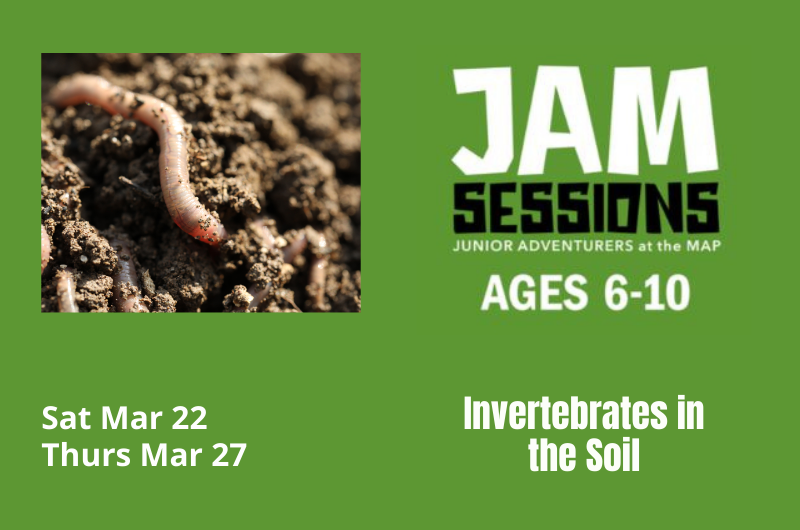
JAM Sessions: Invertebrates in the Soil
If you dig in a patch of dirt, what do you find? Depending on where you dig, you will likely find different living things crawling in and around your sample. What would you expect to find in a sample of wetland soil vs, say, a sample of sandy soil? If you think about what all living things need to survive, this can give you clues to answer this question.
In this JAM, you will look closely at samples of soil collected from different habitats. While we often barely notice what is living under our feet, the tiny soil invertebrates play a huge role in the diversity and health of the habitats we interact with everyday.

Little Explorer’s Club: Crystallization
Join us as we dive into the fascinating world of crystals! In this fun, hands-on class, little explorers will discover how crystals form and grow through exciting experiments and playful activities. We'll explore the process of crystallization and watch as sparkling shapes come to life.

Little Explorer’s Club: Crystallization
Join us as we dive into the fascinating world of crystals! In this fun, hands-on class, little explorers will discover how crystals form and grow through exciting experiments and playful activities. We'll explore the process of crystallization and watch as sparkling shapes come to life.

JAM Sessions: Invertebrates in the Soil
If you dig in a patch of dirt, what do you find? Depending on where you dig, you will likely find different living things crawling in and around your sample. What would you expect to find in a sample of wetland soil vs, say, a sample of sandy soil? If you think about what all living things need to survive, this can give you clues to answer this question.
In this JAM, you will look closely at samples of soil collected from different habitats. While we often barely notice what is living under our feet, the tiny soil invertebrates play a huge role in the diversity and health of the habitats we interact with everyday.
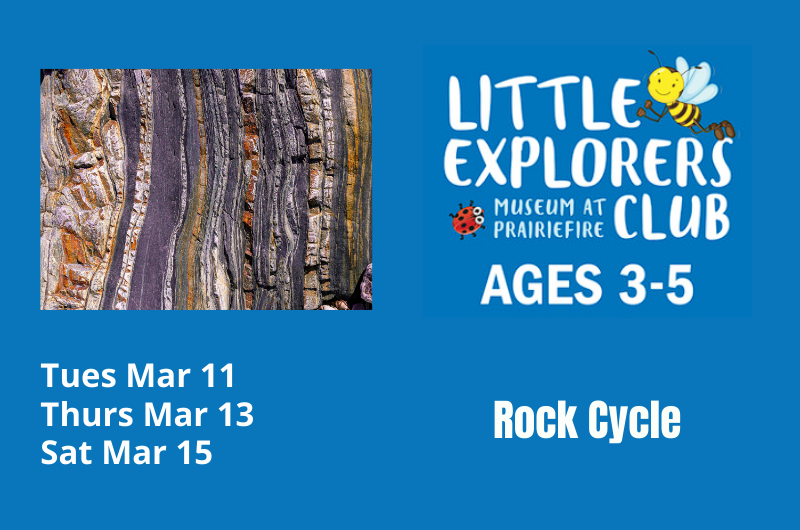
Little Explorer’s Club: Rock Cycle
Join us on a fun adventure to learn all about rocks! In this hands-on class, young explorers will discover the three types of rocks—igneous, sedimentary, and metamorphic—and how the rock cycle transforms them. Through interactive activities, we’ll uncover the secrets of how rocks are made and changed over time.

Little Explorer’s Club: Rock Cycle
Join us on a fun adventure to learn all about rocks! In this hands-on class, young explorers will discover the three types of rocks—igneous, sedimentary, and metamorphic—and how the rock cycle transforms them. Through interactive activities, we’ll uncover the secrets of how rocks are made and changed over time.
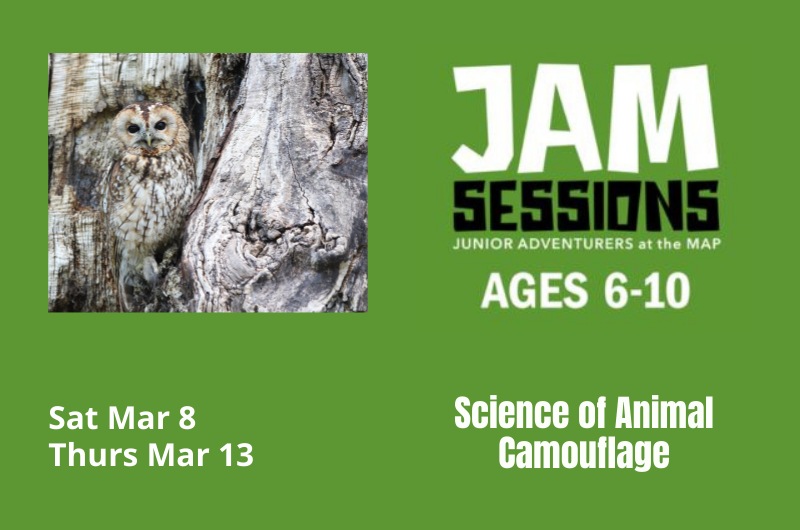
JAM Sessions: Science of Animal Camouflage
How many animals do you think you can spot on a nature walk? Of course, it will depend a lot on where you are. You’ll likely find more things at a state park than you will in your backyard. Still, there are probably a lot of things to see in seemingly unlikely places…but those things are more likely to see you first because they blend into their environment!
In this JAM, you will learn about camouflage. You may know what camouflage is, but what makes certain patterns work so well in one environment and so poorly in another? Something else to think about: what happens when you take a camouflaged object from land and move it into the water? You will look at different camouflaged specimens, make your own camouflage animal patterns, and explore what makes them unique.

Little Explorer’s Club: Rock Cycle
Join us on a fun adventure to learn all about rocks! In this hands-on class, young explorers will discover the three types of rocks—igneous, sedimentary, and metamorphic—and how the rock cycle transforms them. Through interactive activities, we’ll uncover the secrets of how rocks are made and changed over time.

JAM Sessions: Science of Animal Camouflage
How many animals do you think you can spot on a nature walk? Of course, it will depend a lot on where you are. You’ll likely find more things at a state park than you will in your backyard. Still, there are probably a lot of things to see in seemingly unlikely places…but those things are more likely to see you first because they blend into their environment!
In this JAM, you will learn about camouflage. You may know what camouflage is, but what makes certain patterns work so well in one environment and so poorly in another? Something else to think about: what happens when you take a camouflaged object from land and move it into the water? You will look at different camouflaged specimens, make your own camouflage animal patterns, and explore what makes them unique.
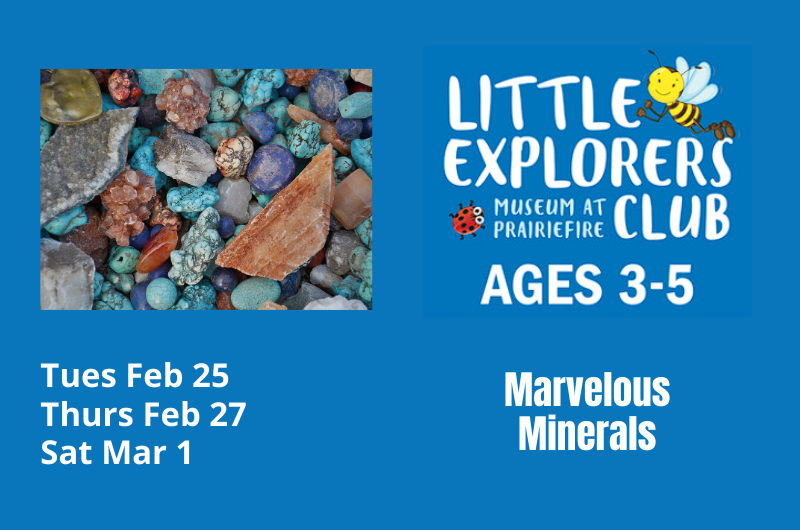
Little Explorer’s Club: Marvelous Minerals
Discover the marvelous world of minerals and how we use them every day. Through interactive activities, stories, and hands-on exploration, children will learn about different types of minerals, their unique properties, and how they impact our lives—from the food we eat to the toys we play with. Get ready for a colorful and educational experience!

Little Explorer’s Club: Marvelous Minerals
Discover the marvelous world of minerals and how we use them every day. Through interactive activities, stories, and hands-on exploration, children will learn about different types of minerals, their unique properties, and how they impact our lives—from the food we eat to the toys we play with. Get ready for a colorful and educational experience!
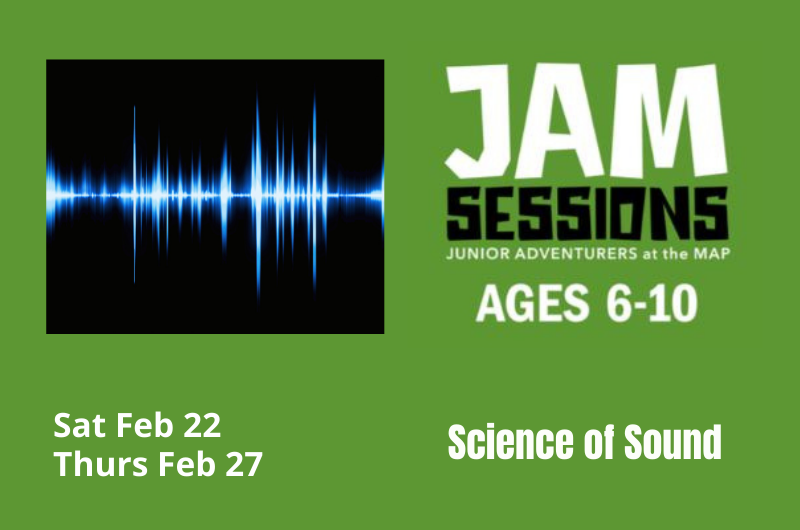
JAM Sessions: Science of Sound
Do you play a musical instrument? Do you sing? Each instrument (and voice) produces a unique sound that can usually be differentiated from one another. For example, the sound of a bassoon is very different from a flute, which is very different from a violin. This is partly due to how high or low a sound is (pitch), but also the sound quality (timbre) and other factors.
In this JAM, you will learn what sound is at the most basic level. With this foundational understanding, we will explore the different ways in which sound can be produced and why these variations result in the huge varieties of sounds we encounter in our everyday lives.

Little Explorer’s Club: Marvelous Minerals
Discover the marvelous world of minerals and how we use them every day. Through interactive activities, stories, and hands-on exploration, children will learn about different types of minerals, their unique properties, and how they impact our lives—from the food we eat to the toys we play with. Get ready for a colorful and educational experience!

JAM Sessions: Science of Sound
Do you play a musical instrument? Do you sing? Each instrument (and voice) produces a unique sound that can usually be differentiated from one another. For example, the sound of a bassoon is very different from a flute, which is very different from a violin. This is partly due to how high or low a sound is (pitch), but also the sound quality (timbre) and other factors.
In this JAM, you will learn what sound is at the most basic level. With this foundational understanding, we will explore the different ways in which sound can be produced and why these variations result in the huge varieties of sounds we encounter in our everyday lives.
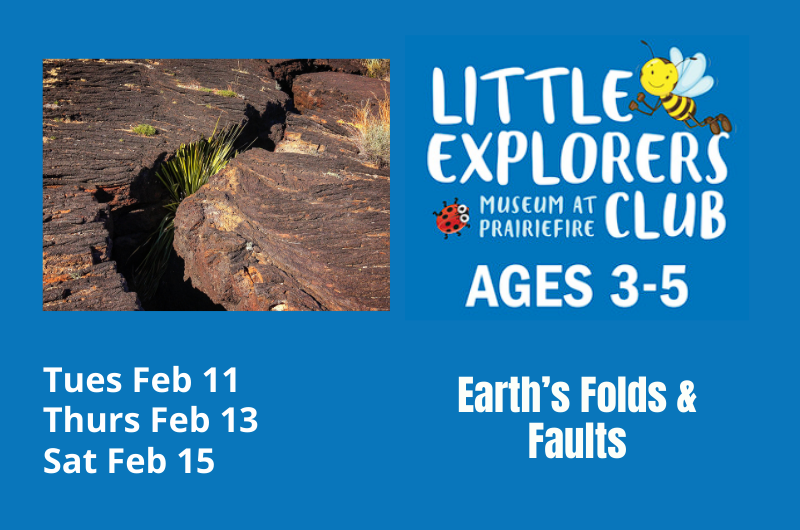
Little Explorer’s Club: Earth’s Folds and Faults
Get ready for a fun adventure as we explore how the surface of the Earth moves! In this hands-on class, young explorers will learn about mountains, valleys, and the amazing forces that create them. Through exciting activities, we'll discover how Earth's folds and faults shape our world.
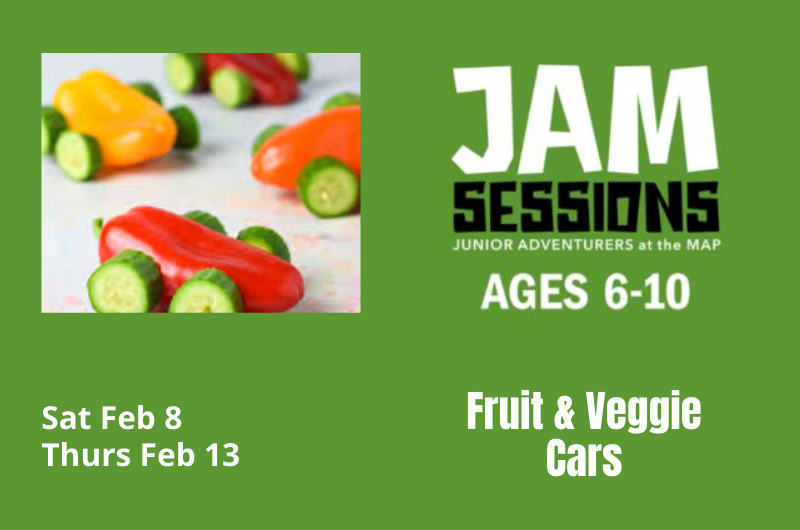
JAM Sessions: Fruit and Veggie Cars
Do your parents tell you not to play with your food? Most of the time, that is good advice! Sometimes, though, there are activities and experiments you can do that encourage you to do the opposite…like building a vehicle out of food! You’ve probably done friction experiments with moving objects before, but this experiment is pretty unique.
You will design and build your own racing “cars” using different kinds of fruits and vegetables. You get to choose which ones you think will work best for different components of your car. What would work best for wheels? How will you make an axle? Finally, you will test your cars on ramps with different surfaces.

Little Explorer’s Club: Earth’s Folds and Faults
Get ready for a fun adventure as we explore how the surface of the Earth moves! In this hands-on class, young explorers will learn about mountains, valleys, and the amazing forces that create them. Through exciting activities, we'll discover how Earth's folds and faults shape our world.

Little Explorer’s Club: Earth’s Folds and Faults
Get ready for a fun adventure as we explore how the surface of the Earth moves! In this hands-on class, young explorers will learn about mountains, valleys, and the amazing forces that create them. Through exciting activities, we'll discover how Earth's folds and faults shape our world.

JAM Sessions: Fruit and Veggie Cars
Do your parents tell you not to play with your food? Most of the time, that is good advice! Sometimes, though, there are activities and experiments you can do that encourage you to do the opposite…like building a vehicle out of food! You’ve probably done friction experiments with moving objects before, but this experiment is pretty unique.
You will design and build your own racing “cars” using different kinds of fruits and vegetables. You get to choose which ones you think will work best for different components of your car. What would work best for wheels? How will you make an axle? Finally, you will test your cars on ramps with different surfaces.
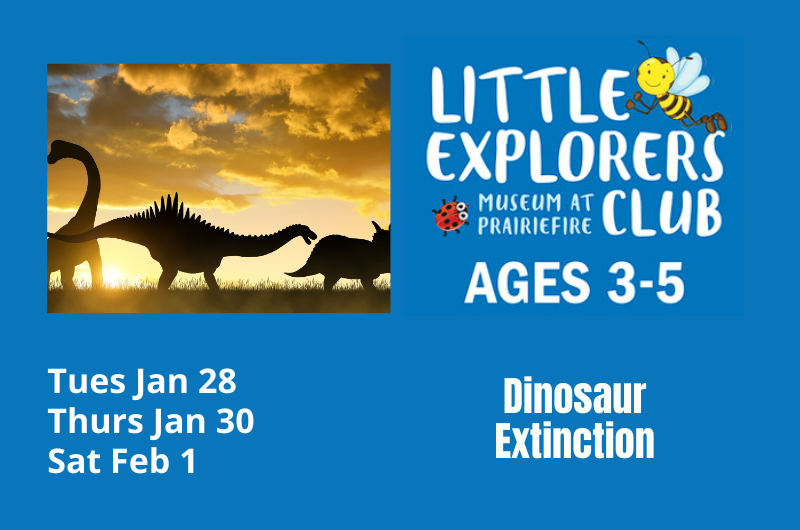
Little Explorer’s Club: Dinosaur Extinction
Step back in time with our Little Explorers as we uncover the mystery of dinosaur extinction! Through fun stories, hands-on activities, and imaginative play, we’ll learn about the events that caused the dinosaurs to disappear millions of years ago. Perfect for curious minds ready to explore the prehistoric world!

JAM Sessions: Science of Ice and Snow
We are coming up to the middle of winter, and chances are we will have had some snow by now. We all know that snow is made of water, and that snowflakes are tiny ice crystals. You may have also heard that no two snowflakes are exactly alike - is this true?
In this winter-themed JAM, you will learn about physical and chemical properties of snow and ice, and what makes the solid state of water (ice) so unique compared to other solid objects. You will also conduct friction tests on ice using different objects to determine which one slides the best.

Little Explorer’s Club: Dinosaur Extinction
Step back in time with our Little Explorers as we uncover the mystery of dinosaur extinction! Through fun stories, hands-on activities, and imaginative play, we’ll learn about the events that caused the dinosaurs to disappear millions of years ago. Perfect for curious minds ready to explore the prehistoric world!

Little Explorer’s Club: Dinosaur Extinction
Step back in time with our Little Explorers as we uncover the mystery of dinosaur extinction! Through fun stories, hands-on activities, and imaginative play, we’ll learn about the events that caused the dinosaurs to disappear millions of years ago. Perfect for curious minds ready to explore the prehistoric world!

JAM Sessions: Science of Ice and Snow
We are coming up to the middle of winter, and chances are we will have had some snow by now. We all know that snow is made of water, and that snowflakes are tiny ice crystals. You may have also heard that no two snowflakes are exactly alike - is this true?
In this winter-themed JAM, you will learn about physical and chemical properties of snow and ice, and what makes the solid state of water (ice) so unique compared to other solid objects. You will also conduct friction tests on ice using different objects to determine which one slides the best.

Little Explorer’s Club: Tyrannosaurus Rex
Step back in time to learn about the mighty Tyrannosaurus rex! In this exciting class, we'll uncover how the T. rex lived, what it ate, and just how massive (or tiny!) it was as a baby. Through fun facts and interactive activities, join us on the Little Explorer’s Club as we discover what made this fierce predator one of the most fascinating dinosaurs of all time.

JAM Sessions: Marble Roller Coasters
Have you ever wondered if you could design your own roller coaster? If you’ve been on one before, think about what made the ride fun (or not so fun), and what design elements it had. Were there loops? Were there lots of turns?
In this engineering JAM, you will work as part of a team to design and build a model roller coaster track using insulation tubing and a marble. The objective is to not just come up with a working design, but to gain an understanding of potential vs. kinetic energy and how the two are related. As your team adds a new component to the track, you will test for fail points so you can improve on your design where needed.

Little Explorer’s Club: Tyrannosaurus Rex
Step back in time to learn about the mighty Tyrannosaurus rex! In this exciting class, we'll uncover how the T. rex lived, what it ate, and just how massive (or tiny!) it was as a baby. Through fun facts and interactive activities, join us on the Little Explorer’s Club as we discover what made this fierce predator one of the most fascinating dinosaurs of all time.

Little Explorer’s Club: Tyrannosaurus Rex
Step back in time to learn about the mighty Tyrannosaurus rex! In this exciting class, we'll uncover how the T. rex lived, what it ate, and just how massive (or tiny!) it was as a baby. Through fun facts and interactive activities, join us on the Little Explorer’s Club as we discover what made this fierce predator one of the most fascinating dinosaurs of all time.

JAM Sessions: Marble Roller Coasters
Have you ever wondered if you could design your own roller coaster? If you’ve been on one before, think about what made the ride fun (or not so fun), and what design elements it had. Were there loops? Were there lots of turns?
In this engineering JAM, you will work as part of a team to design and build a model roller coaster track using insulation tubing and a marble. The objective is to not just come up with a working design, but to gain an understanding of potential vs. kinetic energy and how the two are related. As your team adds a new component to the track, you will test for fail points so you can improve on your design where needed.

Little Explorer’s Club: Snowflakes
Discover the wonder of snowflakes in this engaging Little Explorer’s Club! We'll explore what snowflakes are, how they form in the atmosphere, and why each one is unique. Through hands-on activities, we'll learn about the conditions needed for snowflakes to develop and the science behind their intricate shapes. Perfect for curious minds eager to explore the magic of winter!
